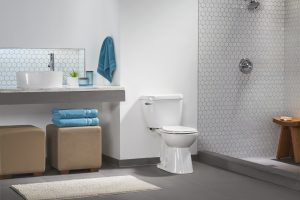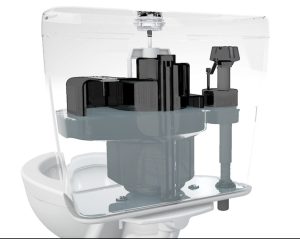 Top Tips for Faster, Better, More Profitable Toilet Installations
Top Tips for Faster, Better, More Profitable Toilet Installations
How many more jobs could your company do each week if replacing a toilet took as little as 10 minutes? How much time and money do you waste on callbacks, such as fixing a rocking toilet? What if layers of flooring and rock-hard putty were minor inconveniences instead of delays getting to the next job?
Follow these five tips to install replacement toilets in single-family homes, apartment complexes, and more—quickly, profitably, and safely.
Tip 1: Choose the right toilet footprint.
The older the toilet, the more likely it’s leaked over the years. But that doesn’t necessarily mean the subfloor around the flange now has to be replaced. If it’s still solid, and the leak has simply discolored the flooring, choose a model whose footprint is large enough to cover that area.
Tip 2: Be prepared to go the distance.
Another common challenge in older homes is layer after layer of linoleum, tile, and other floorings, causing the flange to sit farther down than expected. Extra-long closet bolts or a second flange can help provide the necessary reach when the existing flange sits lower than the finished flooring. All Niagara models have a fully glazed, 2” trapway, which allows waste to move smoothly and efficiently down the path. That also reduces the chance of clogs, which could lead to flange leaks if the homeowner or tenant is overly aggressive with an auger tube or plunger.
Tip 3: Share your experience.
As someone with decades of experience there’s a good chance that you and your longtime employees have replaced toilets in many of the houses and apartments they built—or even installed the originals. Share that experience with your peers or newer employees so they know exactly what to expect and look for when replacing a toilet in those homes.
This institutional knowledge also applies to historic neighborhoods, where original and even replacement toilets often were seated with putty rather than wax rings. In a recent survey conducted by Niagara, 54% of plumbers said removing the old toilet is the hardest part of a replacement job. Sharing hard-won tips about how to break them free without breaking a flange can easily cut a job’s time in half and avoid back strain in the process. A sturdy putty knife and hammer are very handy for removing old putty.
In historic and newer homes alike, a putty knife or a thin saw blade can quickly break through grease or buildup around the bolts to loosen them if stuck. And in hard-to-reach areas, a flexi-drill with a bolt attachment is ideal for removing bolts easily and quickly.
Tip 4: Choose pre-assembled models.

Assembling the tank often is one of the most time-consuming steps. That’s why all Niagara models have preassembled tanks. So instead of tinkering with a flapper, fill valve, and other elements, your plumbers simply place the tank on the toilet base, secure the bolts and water line, and run a few tests.
Some homeowners prefer skirted and/or one-piece models for their design and ease of cleaning. In a recent survey conducted by Niagara, 12% of plumbers said attaching the tank is the hardest part of the installation. One-piece models such as the Niagara Stealth One PieceTM eliminate this step, saving time and money. Concerned about back strain? A weight belt helps ensure that a single plumber can safely install a one-piece.
Another way your employees can quickly install one-piece models by themselves is to wait to attach the seat at the end. Then, they can look through the holes to line up the closet bolts. If this also is an installation where the flooring sits higher than the flange, use the extra nuts to make the bolts sit up straight—it will be easier to line up the holes and lower the toilet onto the bolts.
Tip 5: Get the right kind of callback.
Unexpectedly high water use means unexpectedly high sewer use—problems that unfortunately are common even with toilets that are just a few years old. That was the case at Girard Street Apartments, a 55+ community built-in 2016 in Washington, D.C. An independent audit in 2021 found that the existing toilets had been improperly installed and were using a high GPF.
All 26 toilets were replaced with Niagara’s The Original models with patented Stealth Technology®. The 360-degree rim wash, powerful rim jet, and vacuum-assisted flush clear up to 800g of waste in as little as 0.8 GPF.
Girard immediately saw a 77% reduction in water consumption and a 73% decrease in water and sewer costs—good for a 375% monthly ROI for the owners. In fact, they were so satisfied with Niagara’s The Original that they retrofitted several other properties and are seeing similar results.
The moral is that when you help clients choose the right replacement toilet, it eliminates both the profit-eroding expense and finger-pointing that come with callbacks. That includes choosing a company that stands behind its products for the long haul. All Niagara models come with a 15-year warranty on tank trim—the industry’s longest—plus a lifetime warranty on the china. And in the case of senior living communities and other MDUs, getting it right the first time also can lead to another, better type of callback: repeat business from satisfied customers.
How to Get Started: To learn more about The Original and the rest of the Niagara portfolio, request a product demo.
